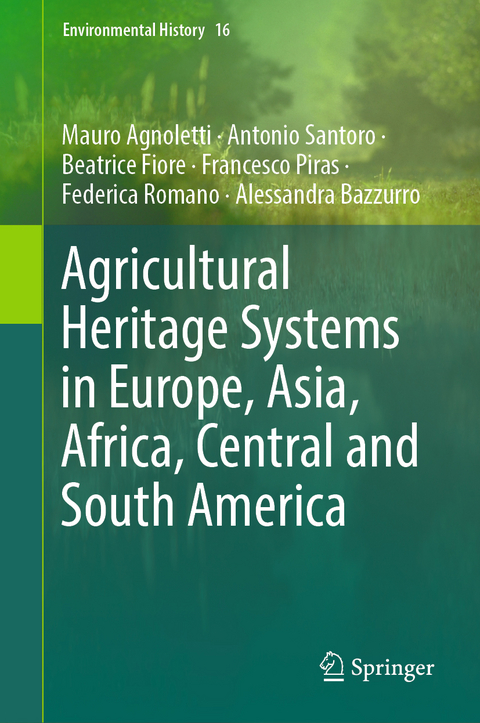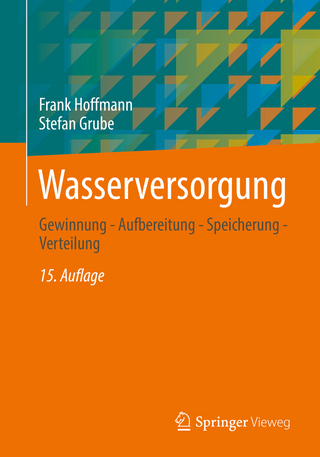
Agricultural Heritage Systems in Europe, Asia, Africa, Central and South America
Springer International Publishing (Verlag)
978-3-031-44880-5 (ISBN)
The use of sustainable and ecological practices is the key feature distinguishing traditional agriculture from intensive one. It may not provide very high yields, but ensures sustainable harvests over time, thanks to time-tested technologies and traditional know-hows and also represent examples of adaptation to harsh environmental conditions. Based on this approach, in 2002, FAO launched the concept of Globally Important Agricultural Heritage Systems (GIAHS) Programme, to identify and safeguard agricultural systems that are ensuring food and livelihood security, while maintaining magnificent landscapes, agricultural biodiversity, traditional knowledge, cultural and social values.
This book presents 18 examples of these traditional agriculture systems around the world, with a special focus on Europe, Asia, Africa, Central and South America, as a result of the "GIAHS Building Capacity" project co-funded by the Italian Agency for Development Cooperation (AICS) and carried out by the Department of Agriculture, Food, Environment and Forestry (DAGRI) of the University of Florence (Italy).
lt;b> Mauro Agnoletti is UNESCO Chair on "Agricultural Heritage Landscapes" and Associate Professor at the School of Agriculture of the University of Florence Italy. He teaches Landscape Planning and Landscape History and coordinates the International Master Course on Agricultural Heritage Systems. He is co-director of the Journal Global Environment (White Horse Press), Director of the Springer Series on Environmental History and Associate Editor of Biodiversity and Conservation (Springer). He is Vice President of the International Association of Landscape Ecology (IALE). He chaired the Scientific Advisory Group of the FAO program Globally Important Agricultural Heritage Systems. Within the International Union of Forest Research Organization he coordinated the research group "Forest History and Traditional Knowledge". He was one of the cofounders of the European Society of Environmental History and served as Vice President. In Italy he coordinated the National Register of Historical Rural Landscapes. In 2014 he coordinated the UNESCO-CBD declaration on the linkages between cultural and biological diversity. His research activity is mostly dedicated to rural landscape,he has written about 250 scientific papers, and 20 books.www.landscape.unifi.it
Antonio Santoro, PhD, is a researcher at the Department of Agriculture, Food, Environment and Forestry (DAGRI) of the University of Florence (Italy), and Deputy Director of the UNESCO Chair on "Agricultural Heritage Landscapes". He is the coordinator of the international project MedAgriFood Resilience, funded under the 2021 joint call SUSFOOD2 and FOSC, that received the official support of the FAO GIAHS Secretariat. He is currently involved in the "GIAHS Building Capacity" project funded by the Italian Agency for Development Cooperation and in the drafting of the Forest Management Plan of the Colline del Prosecco UNESCO site. He participated in two projects of the Italian Ministry of Agricultural Policies, in landscape restoration projects on behalf of the FAI (Italian National Trust), in the drafting of the proposal of the Colline del Prosecco for the UNESCO World Heritage List, in the Management Plan of the UNESCO site Portovenere, Cinque Terre and Islands. He has published about 30 scientific articles in international journals in the fields landscape monitoring, cultural forests, and traditional agroforestry systems.
Beatrice Fiore graduated in Forestry Systems Science and Technology at the University of Florence with a thesis on "Identification of tourist routes aimed at enhancing the historic landscape. The case of the Mona Lisa landscape". She has collaborated in the "GIAHS Building Capacity" project and is currently a researcher at the Department of Agricultural, Food, Environmental and Forestry Sciences of the University of Florence within the project "Investigation for the Forest Reforestation Plan of the core zone of the hills of Conegliano Valdobbiadene inscribed in the UNESCO World Heritage List". She also works as a research assistant of the UNESCO Chair "Agricultural Heritage Landscapes". To date, she has published six scientific articles on forestry, landscape and traditional agriculture.
Francesco Piras graduated in Forest Science and Technology from the University of Florence with a thesis on the evolution of forests in Tuscany. He later collaborated as a researcher on the "GIAHS Building Capacity" project at the Department of Agriculture, Food, Environment, and Forestry of the University of Florence. Currently, he works as a research assistant for the UNESCO Chair on "Agricultural Heritage Landscape" and has published 17 articles in the fields of forestry, landscape, and traditional agriculture.
Federica Romano Italian-Swiss, achieved her Maturity Degree in Switzerland and her Masters' Degree in Communication at the Cagliari U
Introduction.- 1. The FAO Globally Important Agricultural Heritage Systems (GIAHS) programme.- 2. Potential GIAHS sites in Africa.- 2.1. The jessour system, Tunisia; Afef Zanzana.- 2.2. The Mountain Oases, Tunisia; Fadwa Benyahia.- 2.3 The Ketaba agroecology system, Senegal; Alioune Badara Fall.- 2.4 The cultural landscape of Konso, Ethiopia; Yenewa Dessie Alemu, Fethia Abdullahi Ahmed.- 2.5. The Marakwet traditional irrigation system, Kenya; Sheilla Jeruto Tallam.- 2.6. The agroforestry system in Sao Tome and Principe; Joana Rocha Dias.- 3. Potential GIAHS sites in Asia.- 3.1. The floating garden system of the Inle Lake, Myanmar; Moe Thae Oo, Zin Wai Aung.- 3.2. The traditional Naga agricultural system, Myanamr; Ti Chia.- 3.3. The lychee cultivation system in Haikou City, China; Xieli Bai.- 3.4. The ancient terraced agricultural system in Shouf, Lebanon; Marwa Abou Assi.- 3.5. Cultivation of Mohammadi flower and rosewater production system in Barzok, Iran; Mohammad Amin Emadi.- 4. Potential GIAHS sites in Europe.- 4.1. The rainfed mulching agriculture in the volcanic island of Lanzarote, Spain; Marta Arnés.- 4.2. The traditional alpine agriculture in Valtellina and Valposchiavo, Italy-Switzerland; Michelangelo Ferri.- 4.3. The terraced vineyards of Lamole in Chianti, Italy; Francesco Piras.- 4.4. The traditional agricultural system of the hills of Vertop, Albania; Florjan Boduri.- 5. Potential GIAHS sites in Central and South America.- 5.1. The traditional agricultural system in the Sierra del Rosario, Cuba; Alejandro Gonzalez.- 5.2. The sustainable agricultural system of the Sierra Maestra, Cuba; Yenia Molina Pelegrín.- 5.3. The traditional agricultural system of tobacco in Viñales, Cuba; Liane Bárbara Portuondo Farías.- 5.4. The Sabana de Morro agroforestry system in Dolores, El Salvador; Ever Alexis Martínez Aguilar.- 5.5. The "Chakra" agroforestry system of the Kichwa communities, Ecuador; Erika Zárate.- 5.6. The "Chagras" agroforestry system in the Amazon, Colombia; María Alejandra Hernández Marentes.- 5.7. The vertical productive system in the Charazani Valley, Bolivia; Fabiana Navia.- Conclusions.
| Erscheinungsdatum | 07.11.2023 |
|---|---|
| Reihe/Serie | Environmental History |
| Zusatzinfo | IX, 373 p. 56 illus., 53 illus. in color. |
| Verlagsort | Cham |
| Sprache | englisch |
| Maße | 155 x 235 mm |
| Gewicht | 695 g |
| Themenwelt | Naturwissenschaften ► Biologie ► Ökologie / Naturschutz |
| Schlagworte | Agroecology • agroforestry • Cultural Landscape • FAO • GIAHS programme • Responsible Consumption and Production • SDG 12 • sustainable agriculture • Traditional Agriculture • traditional landscape |
| ISBN-10 | 3-031-44880-4 / 3031448804 |
| ISBN-13 | 978-3-031-44880-5 / 9783031448805 |
| Zustand | Neuware |
| Informationen gemäß Produktsicherheitsverordnung (GPSR) | |
| Haben Sie eine Frage zum Produkt? |
aus dem Bereich


